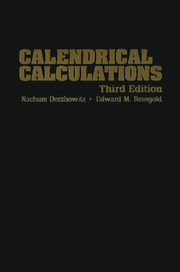Book contents
- Frontmatter
- Dedication
- Contents
- List of Frontispieces
- List of Figures
- List of Tables
- Abbreviations
- Mathematical Notations
- Preface
- Credits
- License and Limited Warranty and Remedy
- About the Cover
- 1 Calendar Basics
- I ARITHMETICAL CALENDARS
- II ASTRONOMICAL CALENDARS
- 13 Time and Astronomy
- 14 The Persian Calendar
- 15 The Bahá'í Calendar
- 16 The French Revolutionary Calendar
- 17 The Chinese Calendar
- 18 The Modern Hindu Calendars
- 19 The Tibetan Calendar
- 20 Astronomical Lunar Calendars
- Coda
- III APPENDICES
- Index
- Envoi
- About the Cover
17 - The Chinese Calendar
Published online by Cambridge University Press: 05 February 2014
- Frontmatter
- Dedication
- Contents
- List of Frontispieces
- List of Figures
- List of Tables
- Abbreviations
- Mathematical Notations
- Preface
- Credits
- License and Limited Warranty and Remedy
- About the Cover
- 1 Calendar Basics
- I ARITHMETICAL CALENDARS
- II ASTRONOMICAL CALENDARS
- 13 Time and Astronomy
- 14 The Persian Calendar
- 15 The Bahá'í Calendar
- 16 The French Revolutionary Calendar
- 17 The Chinese Calendar
- 18 The Modern Hindu Calendars
- 19 The Tibetan Calendar
- 20 Astronomical Lunar Calendars
- Coda
- III APPENDICES
- Index
- Envoi
- About the Cover
Summary
The complexity of calendars is due simply to the incommensurability of the fundamental periods on which they are based…. Calendars based on [the synodic month], depending only on lunations, make the seasons unpredictable, while calendars based on [the tropical year] cannot predict the full moons, the importance of which in ages before the introduction of artificial illuminants was considerable. The whole history of calendar-making, therefore, is that of successive attempts to reconcile the irreconcilable, and the numberless systems of intercalated months, and the like, are thus of minor scientific interest. The treatment here will therefore be deliberately brief.
—Joseph Needham: Science and Civilisation in China (1959)The Chinese calendar is a lunisolar calendar based on astronomical events, not arithmetical rules. Days begin at civil midnight. Months are lunar, beginning on the day of the new moon and ending on the day before the next new moon. Years contain 12 or 13 such months, with the number of months determined by the number of new moons between successive winter solstices. The details of the Chinese calendar have varied greatly—there have been more than 50 calendar reforms—since its inception in the fourteenth century B.C.E.; some of its history, in particular its effect on the development of mathematics in China, is described in [13]; other historical details can be found in [5] and [16].
- Type
- Chapter
- Information
- Calendrical Calculations , pp. 247 - 274Publisher: Cambridge University PressPrint publication year: 2007



